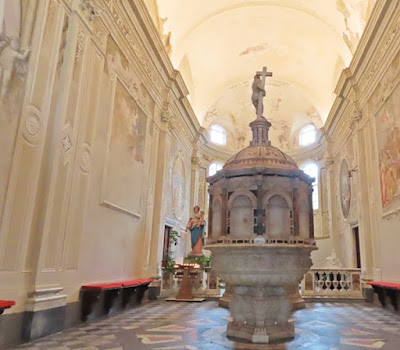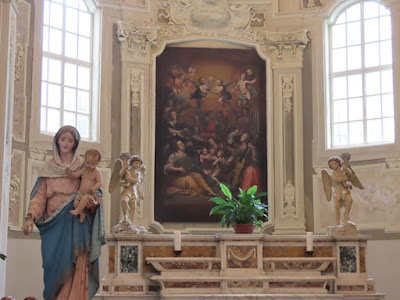Pietrasanta
Pietrasanta is a historical town and lies about 3km inland on the last foothills of the Apuan Alps. The town has always been popular for sculptors and painters and become a gathering place for artists from all over the world, mostly due to its location so close to the marble quarries of Carrara. Famous artists include Michelangelo centuries ago and the contemporary ones like Fernando Botero and Igor Mitoraj.
We were welcome by some pieces of sculpture once left the railway station. As
one walks around the town, it will see contemporary art and sculpture artworks
in the Museo dei Bozzetti and its open-air extension in many streets, squares
and surroundings of Pietrasanta. If you are interested in the pieces of art and
exact locations, be sure to read the map at the entrance of the town.
Apart from sculpture, Pietrasanta is enriched with
numerous historical splendid buildings. Art workshops dot every street. One can
easily feel the creative energy throughout. I like the contrasts of the
‘Antique’ feels of the century-old buildings and the modern spirits /
enthusiasm diffused through the contemporary exhibits in the public area and
private shops. It’s vibrant, competing but still in harmony.
 |
| Shops in Pietrasanta |
At the town centre is the majestic Cathedral of San Martino from the 14th century. The simple yet elegant white marble
exterior catches all attention. Next to it is the independent unfinished brick
church tower which marble coverture was originally planned. Inside is a
master-worked helicoidal shaped staircase designed by Michelangelo Buonarroti.
The Cathedral is dedicated to St. Martin. A beautiful glass window depicts the story of the saint. The splendid building has three aisles and over the portals are lunettes with scenes from the Life of Christ. Three astonishing doors are over hung by fanlights, representing bas-reliefs, the Crocefissione in the center, the Deposition on the left side and the Resurrection on the right.
Art pieces inside the Cathedral are of different periods. An exquisite pulpit with high relief cravings of the four gospel authors and representing animals by Donato Benti (1508) and pedestal by Lorenzo Stagi (1504) stands on the left of the nave.
The walls and the ceilings were painted by the Milanese artist Luigi Ademollo between 1823 and 1825. The ceiling of the dome depicts the Last Judgement.
To the right of the cathedral is the baptistery which was originally as an oratory erected in the 17th century. There are two imposing baptismal fonts. The oldest font (1389) has a hexagonal basin with allegorical depictions of six Virtues and is attributed to Bonuccio Pardini.
The other font, a tabernacle, was entrusted to Donato Benti and Nicola Civitali in 1509 but remained unfinished; the cup with the elegant marine frieze was reused a century later by Fabrizio Pelliccia and Orazio Bergamini who created the foot and the temple roof (1612) completed with small bronze sculptures and the Redeemer by Felice Palma (1615).
The only work remaining from the original seventeenth-century structure is the altarpiece by Filippo Martelli which represents a Eucharist and adoring angels (1636).
In the same Piazza Duomo you can find the deconsecrated church of Sant'Agostino, which has a magnificent cloister and Baroque bell tower as well a sculpture of the Annunciation by renowned artist Mitoraj.
Part of the church is used for The Museo dei Bozzetti. It explores the evolution of modern sculpture through 700-odd bozzetti (maquettes or models) and plaster moulds of famous sculptures cast or carved in Pietrasanta by around 350 artists from all over the world since the early 20th century. The exhibits at the ground floor are of bigger size. Beware of the opening hours. It is normally opened from 9am to 1pm. At our time of visit, it also opened after 2pm. However, it can be closed in the afternoon during the summer months or open in the evening.
 |
| Nascita di Venere by Igor Mitoraj |
In the upper left corner of the piazza is the Teatro Comunale which is a working cinema that shows the latest movies.
One of the historically most important buildings for public functions is the Moroni Palace, locates next to the Duomo. Its most distinguishing feature is the double external staircase and the 19th century classical windows. It was first used for the Chancellery, and which archive of the public administration documents were kept. It was then used by different institutions and lately the "Bruno Antonucci" Versilia Archaeological Museum.
Not to be missed are the two large frescoes "The
Gate of Paradise" and "The Gate of Hell" by Fernando Botero in the church of Misericordia, . In
typical Botero style the figures are large, round, and fleshy. Mother Teresa
resides in heaven, Hitler in hell. The two frescoes are phenomenal and
exceptional. Imagine! Only ancient frescoes are usually found in Italian
churches.






























Comments